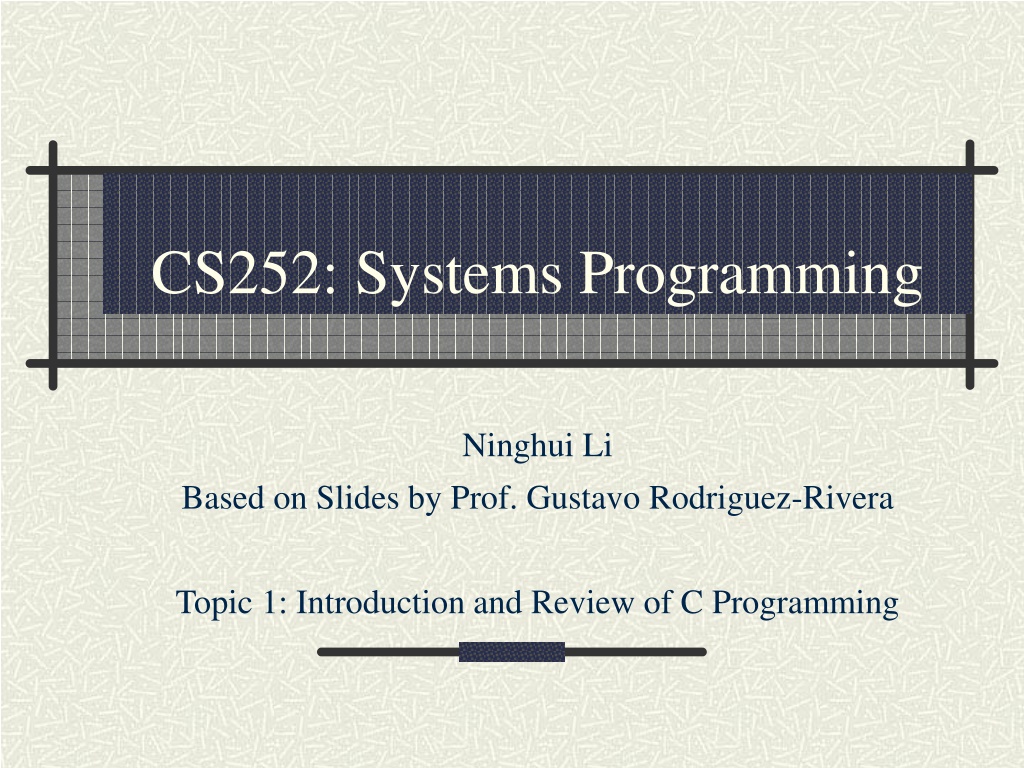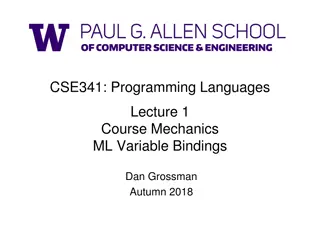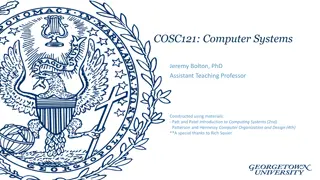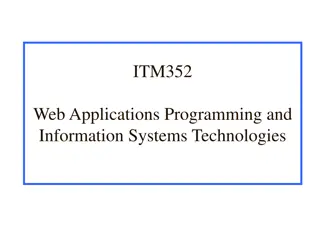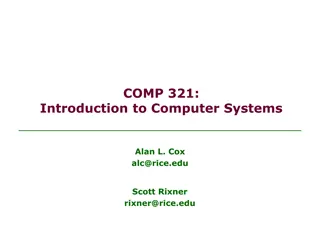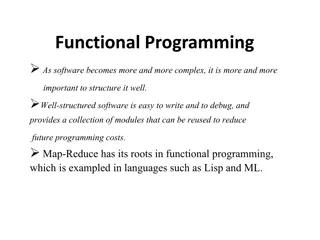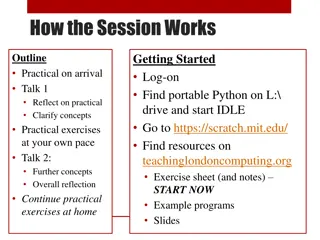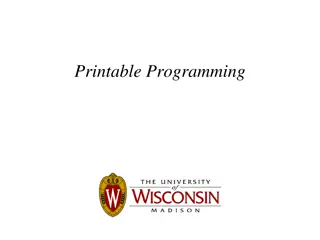CS252 Systems Programming Course Overview
This course overview covers topics such as C programming review, Unix basics, Unix systems programming, and grading details. The course includes labs on C/C++ programming, Unix shell scripting, and writing your own shell. Communication is emphasized through Piazza for questions/answers and Blackboard Learn for grade distribution. Students are recommended to refer to specific materials and utilize tools like GDB for debugging. The grading structure includes midterms, a final exam, and project assignments. The course aims to provide a comprehensive understanding of systems programming concepts using C and Unix environments.
Download Presentation

Please find below an Image/Link to download the presentation.
The content on the website is provided AS IS for your information and personal use only. It may not be sold, licensed, or shared on other websites without obtaining consent from the author.If you encounter any issues during the download, it is possible that the publisher has removed the file from their server.
You are allowed to download the files provided on this website for personal or commercial use, subject to the condition that they are used lawfully. All files are the property of their respective owners.
The content on the website is provided AS IS for your information and personal use only. It may not be sold, licensed, or shared on other websites without obtaining consent from the author.
E N D
Presentation Transcript
CS252: Systems Programming Ninghui Li Based on Slides by Prof. Gustavo Rodriguez-Rivera Topic 1: Introduction and Review of C Programming
General Information Web Page: http://www.cs.purdue.edu/homes/cs252 Office: LWSN2142K E-mail: ninghui@cs.purdue.edu Textbook: No textbook. We will use my notes and selected material in the web Recommended: Advanced Programming in the UNIX Environment by W. Richard Stevens. (Useful for the shell programming lab. Good as a reference book.)
Course Communications Use Piazza for questions/answers, announcements, etc. Use Blackboard Learn for grade distribution
Labs There is no lab the first week. The projects will be explained in the lab sessions. E-mail administrative questions to cs252-ta@cs.purdue.edu Post project questions on Piazza TAs office hours will be posted in the web page.
Grading Grade allocation Midterm 1 (in class): 12.5% Midterm 2 (in class): 12.5% Final: 25% Projects/labs: 50% Six labs, weighted by #of weeks Exams also include questions about the labs.
Course Organization: Part 1: C Programming Review Review of pointers, arrays, pointers to functions Compiling, Assembling, Linking, Loading, Runtime Linker, Static and Shared Libraries; Address space. Structure of a Program. Debugging using GDB. Lab 1: C/C++ Programming and GDB
Course Organization: Part 2: Unix Basics and Using Unix Unix history & file system fundamentals Common Unix utilities Unix Shell scripting Lab 2: Unix Shell Scripting.
Course Organization: Part 3: Unix Systems Programming I Structure of a Unix Shell Using Lex and YACC to create parsers Useful system calls: file creation, read, write, close, file mode, IO redirection, pipes, fork, wait, waitpid, signals, etc. Lab 3: Writing your own shell.
Course Organization: Part 4: Unix Systems Programming II OS kernel fundamentals: user mode, kernel mode, interrupts, system calls Processes, scheduling, Programming with threads, thread creation. Race Conditions, Mutex locks. Lab 4: Introduction to Threads.
Course Organization: Part 5: Unix Network Programming Internet overview: ARP, IP, DNS, TCP, UDP, NAT Socket Programming. Iterative and concurrent servers. Lab 5: Implementing a Web Server
Course Organization: Part 6: Miscellaneous topics 14. Introduction to SQL 15. Source Control Systems (CVS, SVN) and distributed (GIT, Mercurial) 16. Introduction to Software Engineering 17. Design Patterns 18. Execution Profiling. Lab 6: Writing a mobile application (team)
Memory and Pointers A pointer is a variable that contains an address in memory. In a 32 bit architectures, the size of a pointer is 4 bytes independent on the type of the pointer. (4GB-1) 232-1 p:20: 12 Char c = A ; //ascii 65 c:12: 65 char * p = &c; 0 Address space
Ways to get a pointer value (1) 1. Assign a numerical value into a pointer Char * p = (char *) 0x1800; *p = 5; // Store a 5 in location 0x1800; What is likely to happen for the above code? Note: Assigning a numerical value to a pointer isn't recommended and only left to programmers of OS, kernels, or device drivers
What is Likely to Happen Using Absolute Value Pointers When programmer doesn t what he is doing Immediate core dump. Mysterious program crash/misbehaving in the future When programmer knows Program function as expected, as this is part of OS kernel or device driver This is part of exploit code for breaking into a computer
Ways to get a pointer value (2) 2. Get memory address from another variable: int *p; int buff[ 30]; p = &buff[1]; *p =78; 220: buff[29]:216: buff[1]:104: 78 buff[0]:100: P: 96: 104
Ways to get a pointer value (3) 3. Allocate memory from the heap int *p p = new int; int *q; q = (int*)malloc(sizeof(int));
Using pointers You can pass a pointer as a parameter to a function if you want the function to modify the content of the parameters void swap (int *a, int *b){ int temp; temp=*a; *a=*b; *b=temp; } In main: swap(&x, &y)
Understanding Call by Value and Call by Reference C Tutorial Call by Value or Call by Reference http://www.codingunit.com/c-tutorial-call-by- value-or-call-by-reference Java With Us: Call by Value and Call by Reference http://www.javawithus.com/tutorial/call-by- value-and-call-by-reference
Common Problems with Pointers When using pointers, make sure the pointer is pointing to valid memory before assigning or getting any value from the location Many string utility functions do not allocate memory for you: char *s; strcpy(s, "hello"); --> SEGV(uninitialized pointer) The only string function that allocates memory is strdup (it calls malloc with the length of the string and copies it)
Printing Pointers It is useful to print pointers for debugging char*i; char buff[10]; printf("ptr=%d\n", &buff[5]) Or In hexadecimal printf("ptr=0x%x\n", &buff[5]) Instead of using printf, it is better to use fprintf(stderr, ) since stderr is unbuffered and it is guaranteed to be printed on the screen.
sizeof() operator in Pointers The size of a pointer is always 4 bytes in a 32 bit architecture independent of the type of the pointer: sizeof(int)==4 bytes sizeof(char)==1 byte sizeof(int*)==4 bytes sizeof(char*)==4 bytes
Using Pointers to Optimize Execution The following function adds the sum of integers in an array using array indexing. int sum(int * array, int n){ int s=0; for(int i=0; i<n; i++) { s+=array[i]; // Equivalent to //*(int*)((char*)array+i*sizeof(int)) } return s; }
Using Pointers to Optimize Execution Now the equivalent code using pointers int sum(int* array, int n) { int s=0; int *p=&array[0]; int *pend=&array[n]; while (p < pend) { s+=*p; p++; } return s; }
Using Pointers to Optimize Execution When you increment a pointer to integer it will be incremented by 4 units because sizeof(int)==4. Using pointers is more efficient because no indexing is required and indexing require multiplication. Note: An optimizer may substitute the multiplication by a << operator if the size is a power of two. However, the array entries may not be a power of 2 and integer multiplication may be needed.
Array Operator Equivalence We have the following equivalences: int a[20]; a[i] - is equivalent to *(a+i) - is equivalent to *(&a[0]+i) is equivalent to *((int*)((char*)&a[0]+i*sizeof(int))) You may substitute array indexing a[i] by *((int*)((char*)&a[0]+i*sizeof(int))) and it will work! C was designed to be machine independent
2D Array. 1st Implementation a[3][2]:144: 1st approach Normal 2D array. int a[4][3]; a[3][1]:140: a[3][0]:136: a[2][2]:132: a[2][1]:128: a[2][0]:124: a[i][j] == *(int*)((char*)a + i*3*sizeof(int) + j*sizeof(int)) a[1][2]:120: a[1][1]:116: a[1][0]:112: a[0][2]:108: a[0][1]:104: a[0][0]:100: a:
2D Array 2nd Implementation 2nd approach Array of pointers to rows int* (a[4]); for(int i=0; i<4; i++){ a[i]=(int*)malloc(sizeof(int)*3); assert(a[i]!=NULL); }
2D Array 2nd Implementation 2nd approach Array of pointers to rows (cont) a: a[3][0] a[3][1] a[3][2] a[3]:112: a[2][0] a[2][1] a[2][2] a[2]:108: a[1]:104: a[1][0] a[1][1] a[1][2] a[0]:100: a[0][0] a[0][1] a[0][2] int*(a[4]); a[3][2]=5
2D Array 3rd Implementation 3rd approach. a is a pointer to an array of pointers to rows. int **a; a=(int**)malloc(4*sizeof(int*)); assert( a!= NULL) for(int i=0; i<4; i++) { a[i]=(int*)malloc(3*sizeof(int)); assert(a[i] != NULL) }
2D Array 3rd Implementation a is a pointer to an array of pointers to rows. (cont.) int **a; a[3][2]=5 a:100: 900 a[3][0] a[3][1] a[3][2] a[3]:912: a[2][0] a[2][1] a[2][2] a[2]:908: a[1]:904: a[1][0] a[1][1] a[1][2] a[0]:900: a[0][0] a[0][1] a[0][2]
Advantages of Pointer Based Arrays You don t need to know in advance the size of the array (dynamic memory allocation) You can define an array with different row sizes You do not need to know how many rows there are when writing the program
Advantages of Pointer Based Arrays Example: Triangular matrix int **a; a:100: 900: a[3][0] a[3]:912: a[2][0] a[2][1] a[2]:908: a[1]:904: a[1][0] a[1][1] a[1][2] a[0]:900: a[0][0] a[0][1] a[0][2] a[0][3]
Pointers to Functions Pointers to functions are often used to implement Polymorphism in C . Polymorphism: Being able to use the same function with arguments of different types. Example of function pointer: typedef void (*FuncPtr)(int a); FuncPtr is a type of a pointer to a function that takes an int as an argument and returns void .
An Array Mapper typedef void (*FuncPtr)(int a); void intArrayMapper( int *array, int n, FuncPtr func ) { for( int = 0; i < n; i++ ) { (*func)( array[ i ] ); } } int s = 0; void sumInt( int val ){ s += val; } void printInt( int val ) { printf("val = %d \n", val); }
Using the Array Mapper int a[ ] = {3,4,7,8}; main( ){ // Print the values in the array intArrayMapper(a, sizeof(a)/sizeof(int), printInt); // Print the sum of the elements in the array s = 0; intArrayMapper(a, sizeof(a)/sizeof(int), sumInt); printf( total=%d\ , s); }
A More Generic Mapper typedef void (*GenFuncPtr)(void * a); void genericArrayMapper( void *array, int n, int entrySize, GenFuncPtr fun ) { for( int i = 0; i < n; i++; ){ void *entry = (void*)( (char*)array + i*entrySize ); (*fun)(entry); } }
Using the Generic Mapper void sumIntGen( void *pVal ){ //pVal is pointing to an int //Get the int val int *pInt = (int*)pVal; s += *pInt; } void printIntGen( void *pVal ){ int *pInt = (int*)pVal; printf("Val = %d \n", *pInt); }
Using the Generic Mapper int a[ ] = {3,4,7,8}; main( ) { // Print integer values s = 0; genericArrayMapper( a, sizeof(a)/sizeof(int), sizeof(int), printIntGen); // Compute sum the integer values genericArrayMapper( a, sizeof(a)/sizeof(int), sizeof(int), sumIntGen); printf( s=%d\n , s); }
Swapping two Memory Ranges In the lab1 you will implement a sort function that will sort any kind of array. Use the array mapper as model. When swapping two entries of the array, you will have pointers to the elements (void *a, *b) and the size of the entry entrySize. void * tmp = (void *) malloc(entrySize); assert(tmp != NULL); memcpy(tmp, a, entrySize); memcpy(a,b , entrySize); memcpy(b,tmp , entrySize); Note: You may allocate memory only once for tmp in the sort method and use it for all the sorting to save muliple calls to malloc. Free tmp at the end.
String Comparison in Sort Function In lab1, in your sort function, when sorting strings, you will be sorting an array of pointers, that is, of "char* entries. The comparison function will be receiving a pointer to char* or a char** as argument. int StrComFun( void *pa, void *pb) { char** stra = (char**)pa; char ** strb = (char**)pb; return strcmp( *stra, *strb); }
